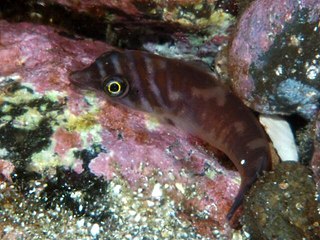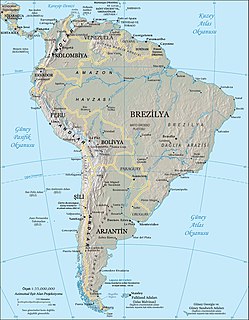
Cod is the common name for the demersal fish genus Gadus, belonging to the family Gadidae. Cod is also used as part of the common name for a number of other fish species, and one species that belongs to genus Gadus is commonly not called cod.

Gadus is a genus of demersal fish in the family Gadidae, commonly known as cod, although there are additional cod species in other genera. The best known member of the genus is the Atlantic cod.

The poor cod, Trisopterus minutus, is a temperate marine fish belonging to the cod family (Gadidae). It is red brown in colour and has a pronounced chin barbel. It may grow up to a length of 40 cm. It is usually found in small shoals at depths between 10 and 300 metres on muddy or sandy bottoms. Its distribution spans the eastern Atlantic, from Norwegian coasts to Portugal and along the Atlantic coast of Morocco; also in the Mediterranean. Spawning takes place towards the end of winter. They are often regarded as a mini species and are commonly confused with pouting as they have a similar appearance. They are often seen as a menace for anglers and have little commercial value and so are not currently at any risk of extinction.

The Arrau turtle, also known as the South American river turtle, giant South American turtle, giant Amazon River turtle, Arrau sideneck turtle, Amazon River turtle or simply the Arrau, is the largest of the side-neck turtles (Pleurodira) and the largest freshwater turtle in Latin America. The species primarily feeds on plant material and typically nests in large groups on beaches. Due to hunting of adults, collecting of their eggs, pollution, habitat loss, and dams, the Arrau turtle is seriously threatened.

The Old World silversides are a family, Atherinidae, of fish in the order Atheriniformes. They occur worldwide in tropical and temperate waters. About two-thirds of the species are marine, and the remainder live in fresh water. The 74 species are in 13 genera. The genus Craterocephalus is the most diverse with 25 species. Four genera are monotypic.

The collared peccary is a species of artiodactyl (even-toed) mammal in the family Tayassuidae found in North, Central, and South America. It is the only member of the genus Dicotyles. They are commonly referred to as javelina, saíno, or báquiro, although these terms are also used to describe other species in the family. The species is also known as the musk hog. In Trinidad, it is colloquially known as quenk.

Microsciurus or dwarf squirrels is a genus of squirrels from the tropical regions of Central and South America.

The pygmy hog is a suid native to alluvial grasslands in the foothills of the Himalayas at elevations of up to 300 m (980 ft). Today, the only known population lives in Assam, India and possibly southern Bhutan. As the population is estimated at less than 250 mature individuals, it is listed as Endangered on the IUCN Red List.

Sanzinia madagascariensis, also known as the Malagasy tree boa, or Madagascar tree boa) is a non-venomous boa species endemic to the island of Madagascar. It was considered conspecific with the Nosy Komba ground boa.

The New Zealand smooth skate is a skate of the genus Dipturus, found around New Zealand at depths between 15 and 1,300 m.

Clingfishes are fishes of the family Gobiesocidae, the only family in the order Gobiesociformes. These fairly small to very small fishes are widespread in tropical and temperate regions, mostly near the coast, but a few species in deeper seas or fresh water. Most species shelter in shallow reefs or seagrass beds, clinging to rocks, algae and seagrass leaves with their sucking disc, a structure on their chest.

Oligoryzomys nigripes, also known as the black-footed colilargo or the black-footed pygmy rice rat, is a rodent in the genus Oligoryzomys of family Cricetidae. Oligoryzomys nigripes is a species that has been further divided into different sister taxa throughout history. It is found in different countries in South America. It is a large species with long ears, dark yellow to dark brown upperparts, sharply delimited from the whitish underparts, and often a pink girdle on the chest. This species of rat spends much of its life among the trees. The karyotype is 2n = 62, FNa = 78–82.

The blue-bellied poison frog or bluebelly poison frog is a species of frogs in the family Dendrobatidae.

The longtail butterfly ray is a species of butterfly ray, family Gymnuridae, native to the Indo-Pacific from the Red Sea to southern Japan and western Indonesia. Growing up to 92 cm (36 in) across, this ray has a lozenge-shaped pectoral fin disc about twice as wide as long, colored brown to gray above with many small, light spots. The spiracles behind its eyes have smooth rims. This species can be identified by its tail, which is about as long as the snout-to-vent distance, lacks fins, and bears nine to twelve each of alternating black and white bands.

The Alaska pollock or walleye pollock is a marine fish species of the cod genus Gadus and family Gadidae. It is a semi-pelagic schooling fish widely distributed in the North Pacific, with largest concentrations found in the eastern Bering Sea.

Cavefish or cave fish is a generic term for fresh and brackish water fish adapted to life in caves and other underground habitats. Related terms are subterranean fish, troglomorphic fish, troglobitic fish, stygobitic fish, phreatic fish and hypogean fish.
Trisopterus esmarkii, the Norway pout, is a species of fish in the cod family. It is found in the Barents Sea, North Sea, Baltic Sea, off the coasts of Norway, Iceland, the British Isles and elsewhere in the northeast Atlantic Ocean. It prefers depths between 100 and 200 m (330–660 ft), but occurs from 50 to 300 m (160–980 ft). Norway pout can reach 35 cm (14 in), but are more common at around 19 cm (7.5 in).

Trisopterus is a genus of small cods native to the northeastern Atlantic Ocean including the Mediterranean Sea.
Spinitectoides is a genus of parasitic nematodes, belonging to the family Cystidicolidae. Species of Spinitectoides are parasitic as adults in the gastrointestinal tract of fish. According to the World Register of Marine Species, the genus currently (2019) includes a single species, Spinitectoides berlandi.


















